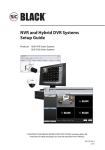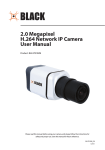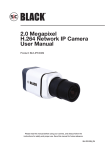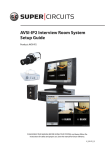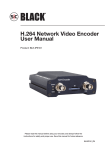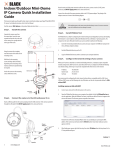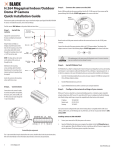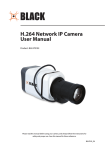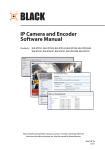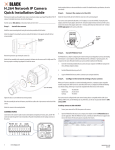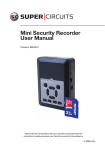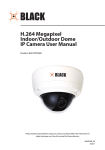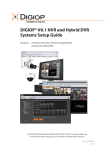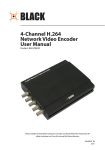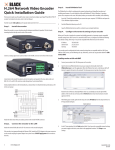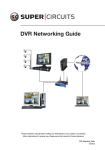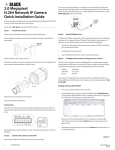Download Black BLK-SY20 Series Setup guide
Transcript
® NVR and Hybrid DVR Systems Setup Guide Products: BLK-SY10 Series Systems BLK-SY20 Series Systems PLEASE READ THIS MANUAL BEFORE USING YOUR SYSTEM, and always follow the instructions for safety and proper use. Save this manual for future reference. BLK-SY10X-20X_SI 6/23/10 CAUTION Operate this system only in environments where the temperature and humidity is within the recommended range. Operation in temperatures or at humidity levels outside the recommended range may cause electric shock and shorten the life of the product. Refer to the specifications for each system component for more information. LEGAL NOTICE SC Black is a registered trademark of Supercircuits, Inc. Supercircuits products are designed to meet safety and performance standards with the use of specific Supercircuits authorized accessories. Supercircuits disclaims liability associated with the use of nonSupercircuits authorized accessories. The recording, transmission, or broadcast of any person’s voice without their consent or a court order is strictly prohibited by law. Supercircuits makes no representations concerning the legality of certain product applications such as the making, transmission, or recording of video and/or audio signals of others without their knowledge and/or consent. We encourage you to check and comply with all applicable local, state, and federal laws and regulations before engaging in any form of surveillance or any transmission of radio frequencies. Other trademarks and trade names may be used in this document to refer to either the entities claiming the marks and names or their products. Supercircuits, Inc. disclaims any proprietary interest in trademarks and trade names other than its own. No part of this document may be reproduced or distributed in any form or by any means without the express written permission of Supercircuits, Inc. © 2010 Supercircuits, Inc. All rights reserved. 11000 N. Mopac Expressway, Building 300, Austin, TX 78759 Sales/Support: 1.800.335.9777 | Fax: 1.866.267.9777 ii www.sc-black.com TABLE OF CONTENTS Table of Contents SECTION 1 Systems Overview. . . . . . . . . . . . . . . . . . . . . . . . . . . . . . . . . . . . . . . . . . . . . . . . 2 SECTION 2 Getting Started: Unpacking Your System. . . . . . . . . . . . . . . . . . . . . . . . . . . . . . . 4 2.1 Unpacking the equipment . . . . . . . . . . . . . . . . . . . . . . . . . . . . . . . . . . . . . . 4 SECTION 3 Equipment Testing and System Setup. . . . . . . . . . . . . . . . . . . . . . . . . . . . . . . . . 5 3.1 Check LAN for default IP address compatibility. . . . . . . . . . . . . . . . . . . . . . 6 3.2 Determine the network settings for each IP device . . . . . . . . . . . . . . . . . . . 7 3.3 Install the IPAdmin Tool. . . . . . . . . . . . . . . . . . . . . . . . . . . . . . . . . . . . . . . . 7 3.4 Connect the camera to the LAN. . . . . . . . . . . . . . . . . . . . . . . . . . . . . . . . . . 7 3.5 Configure the camera IP address. . . . . . . . . . . . . . . . . . . . . . . . . . . . . . . . . 8 3.6 Connect to the camera with IE. . . . . . . . . . . . . . . . . . . . . . . . . . . . . . . . . . . 9 3.7 Repeat for all IP cameras. . . . . . . . . . . . . . . . . . . . . . . . . . . . . . . . . . . . . . 11 3.8 Install each camera at its surveillance location . . . . . . . . . . . . . . . . . . . . . 11 3.9 Install and setup the NVR or hDVR . . . . . . . . . . . . . . . . . . . . . . . . . . . . . . 11 3.9.1 Install and setup the monitor. . . . . . . . . . . . . . . . . . . . . . . . . . . . . . . 11 3.9.2 Starting the NVR/hDVR system software. . . . . . . . . . . . . . . . . . . . . . 13 3.9.3 Log in. . . . . . . . . . . . . . . . . . . . . . . . . . . . . . . . . . . . . . . . . . . . . . . . . 14 3.9.4 Configure NVR/hDVR network settings. . . . . . . . . . . . . . . . . . . . . . . 15 3.9.5 Add IP cameras to the system . . . . . . . . . . . . . . . . . . . . . . . . . . . . . 16 3.10Setup Reflection software . . . . . . . . . . . . . . . . . . . . . . . . . . . . . . . . . . . . . 21 3.10.1 Install Reflection . . . . . . . . . . . . . . . . . . . . . . . . . . . . . . . . . . . . . . . . 21 3.10.2 Connect Reflection to the NVR/hDVR. . . . . . . . . . . . . . . . . . . . . . . . . 21 SECTION 4 Installation Tips. . . . . . . . . . . . . . . . . . . . . . . . . . . . . . . . . . . . . . . . . . . . . . . . . 24 APPENDIX A FAQ . . . . . . . . . . . . . . . . . . . . . . . . . . . . . . . . . . . . . . . . . . . . . . . . . . . . . . . . . . 26 APPENDIX B Troubleshooting. . . . . . . . . . . . . . . . . . . . . . . . . . . . . . . . . . . . . . . . . . . . . . . . . 27 B.1 Camera reset. . . . . . . . . . . . . . . . . . . . . . . . . . . . . . . . . . . . . . . . . . . . . . . 27 B.2 Set to factory default settings . . . . . . . . . . . . . . . . . . . . . . . . . . . . . . . . . . 27 B.3 Checking your Firmware . . . . . . . . . . . . . . . . . . . . . . . . . . . . . . . . . . . . . . 27 B.4 Support. . . . . . . . . . . . . . . . . . . . . . . . . . . . . . . . . . . . . . . . . . . . . . . . . . . 28 APPENDIX C Power over Ethernet. . . . . . . . . . . . . . . . . . . . . . . . . . . . . . . . . . . . . . . . . . . . . . 29 C.1 PoE compatibility. . . . . . . . . . . . . . . . . . . . . . . . . . . . . . . . . . . . . . . . . . . . 29 C.2 Power classification. . . . . . . . . . . . . . . . . . . . . . . . . . . . . . . . . . . . . . . . . . 29 APPENDIX D IP Device Summary. . . . . . . . . . . . . . . . . . . . . . . . . . . . . . . . . . . . . . . . . . . . . . 30 NVR and hDVR Systems Setup Guide 1 SECTION 1: SYSTEM OVERVIEW SECTION 1 Systems Overview SC Black Network Video Recorder (NVR) and Hybrid Digital Video Recorder (hDVR) security systems feature state-of-the-art management for advanced IP and analog cameras. These systems can be used to configure IP cameras, record and store digital video and images, control camera PTZ, and improve the video quality (brightness, contrast, chroma U and V, hue, and gain) of analog cameras. It also includes several surveillance management features including system security and activity logging. All BLK-SY10 and BLK-SY20 systems include Reflection software, a stand-alone Microsoft® Windows® based video dashboard. It provides remote viewing and management of live and recorded IP video with search, playback and download. Reflection accesses your cameras and stored video through your NVR or hDVR. It can be used to monitor one camera up to a multi-NVR/hDVR operation. All SC Black IP cameras and encoders include an IPAdmin Tool, a Microsoft Windows-based application for configuring IP camera network settings and firmware updates. Depending on your system, the IPAdmin Tool may be pre-installed on your NVR or hDVR. Additionally, all BLK-SY10 and BLK-SY20 systems include an 8-port Power over Ethernet (PoE) switch. For more information about PoE and your IP cameras and encoders, refer to Appendix C. 2 www.sc-black.com SECTION 1: SYSTEM OVERVIEW NVR and hDVR Systems Setup Guide 3 SECTION 2: GETTING STARTED: UNPACKING YOUR SYSTEM SECTION 2 Getting Started: Unpacking Your System For most installations, SC Black NVR and hDVR systems come with everything needed to install and operate your surveillance system. 2.1 Unpacking the equipment Remove the equipment from its packaging and place it on a flat, clean surface. Inspect each item. If any visible damage is present, contact your supplier or Supercircuits for a replacement. Verify that your order is complete. Within your order you should find: • • • • • The number of cameras you ordered. Each IP camera includes a roll of cable, a power supply, a software CD, and a Quick Installation Guide. Depending on your camera, other items may be included. Monitor with the associated video and power cables, remote control, and documentation NVR or hDVR with power cables, keyboard and mouse, software CD, and documentation. Power over Ethernet (PoE) switch. Accessories you ordered. Refer to the user manual for the product for a list of specific items included with the product. The user manual may be provided on the CD included with the product. NOTE 4 Large systems may be shipped in several cartons. www.sc-black.com SECTION 3: EQUIPMENT TESTING AND SYSTEM SETUP SECTION 3 Equipment Testing and System Setup All SC Black IP cameras and encoders are pre-configured with the same static IP address, subnet mask, and gateway settings: IP address: 192.168.0.100 Subnet mask: 255.255.255.0 Gateway: 192.168.0.1 Since the IP address is the same for all IP cameras and encoders, they must be attached to the network and configured one at a time. The general procedure for testing and setting up your IP camera system includes the following steps: 1. Check the LAN for default IP address compatibility. See subsection 3.1. 2. Determine the network settings for each device you will install on your network. See subsection 3.2. 3. Install the IPAdmin Tool on a PC connected to the LAN where the IP cameras will be installed. See subsection 3.3. 4. Connect the camera to the LAN (see subsection 3.4) and use the IPAdmin Tool to change the camera network settings. See subsection 3.5. 5. Use the IE browser to verify video and connectability of the camera. See subsection 3.6. 6. Repeat the previous two steps for each IP camera (using a different IP address for each camera). See subsection 3.7. 7. Install each camera at its surveillance location. Perform specific configuration setup for each camera. See subsection 3.8. 8. Install and setup the NVR or hDVR. (Refer to the NVR/hDVR Installation Guides and the System Technical Guide documents.) See subsection 3.9.. – 3.9.4. 9. Configure the NVR/hDVR for each IP camera (add IP cameras to the management system). For hDVRs attach analog cameras. See subsection 3.9.5. Verify connectability with and video from the IP cameras at the NVR/hDVR. NVR and hDVR Systems Setup Guide 5 SECTION 3: EQUIPMENT TESTING AND SYSTEM SETUP 10. Install Reflection on a PC and setup a connection to the NVR/hDVR. Verify functionality. See subsection 3.10. 3.1 Check LAN for default IP address compatibility Because all SC Black cameras and encoders are factory configured with the static IP address 192.168.0.100, check the LAN before connecting your camera to ensure that network conflicts won’t occur. At a Microsoft Windows computer attached to the LAN subnet where the camera will be connected (surveillance network), open a Command Prompt window (press and hold down the Windows key and press r) and Open cmd. At the command prompt, enter: ping 192.168.0.100 The “Request timed out” response indicates that the IP address is not currently in use and the camera can probably be connected without causing conflicts. A “Reply from ..” message received from a ping indicates that an active device with that IP address exists on the network, and new devices with that address shouldn’t be attached to that network. In the latter case, find a network where 192.168.0.100 is not in use, and configure your cameras on that network before installing them on the surveillance network. 6 www.sc-black.com SECTION 3: EQUIPMENT TESTING AND SYSTEM SETUP 3.2 Determine the network settings for each IP device Consult with your LAN network administrator to obtain a list of network settings for each IP device, including the NVR or hDVR and all cameras and encoders, you will attach to your LAN. You must use static IP address for your surveillance system to ensure connectability with the NVR or hDVR. The table included in Appendix D may be useful for logging your network settings. To determine (or verify) which IP address are available on your surveillance network, use the ping command to test the address as shown in section 3.1. 3.3 Install the IPAdmin Tool The IPAdmin Tool, included on the CD disk with all SC Black IP cameras and encoders, will discover all SC Black IP cameras and encoders attached to your network. It is used to perform the initial network setup for each camera and encoder, and install firmware updates. The IPAdmin Tool can be loaded on a Microsoft Windows XP, Vista, or Windows 7 operating system. To install the IPAdmin Tool, do the following: 1. Create a directory on your computer hard drive for the IPAdmin Tool application files. 2. Insert the CD disk provided with your camera or encoder into your computer’s CD ROM drive and open the CD in a Windows Explorer window. 3. Copy the files IPAdminTool.exe and IPAdminTool.dll from the CD to your new directory. 3.4 Connect the camera to the LAN If the camera you are testing has a detached lens, refer to the Quick Installation Guide for instructions for attaching the lens. Connect your IP camera to the LAN in a convenient location to reconfigure its network settings and verify connectability. Use the Quick Installation Guide provided with your camera to attach the power and LAN. If your camera will be powered with a PoE switch, use this switch in the power/LAN connection to also verify the functionality of the switch. Refer to Appendix C for more information about PoE powering and your camera. NVR and hDVR Systems Setup Guide 7 SECTION 3: EQUIPMENT TESTING AND SYSTEM SETUP 3.5 Configure the camera IP address 1. Open the Windows directory where you installed IPAdmin Tool. Double click IPAdminTool.exe to start the application. When the IPAdmin Tool starts, it will discover all of the support IP cameras and encoders that exist on the network. The discovery process may take several minutes. IPAdmin Tool discovered 192.168.0.100 NOTE When a camera is powered on, it will not respond to network commands until it is fully initialized. The initialization process can take up to 2 minutes. 3. In the Product list, find the entry with the same MAC address as the camera you are configuring. If the camera is not shown, click Refresh repeatedly to update the list. 4. Right click on the entry for your camera and select IP Address. 5. In the IP Setup window: 8 www.sc-black.com SECTION 3: EQUIPMENT TESTING AND SYSTEM SETUP a. Select the Static option if it is not selected. This option is required to record camera video by a network NVR or hDVR. b. Enter the new IP address, subnet mask, and gateway address into the appropriate fields. c. Click SETUP. A Login window will open. IP Setup window d. 6. In the Login window, enter the ID and PW (password) for your camera and click Login. The default administrator values for the ID and PW are root and pass. After entering the ID and PW, the IP Setup window will close. In the IPAdmin Tool window, click Refresh and verify that the entry representing the camera now shows the new IP address. 3.6 Connect to the camera with IE To further test the connectability of the camera (network settings) and verify video streaming: 1. Open Microsoft Internet Explorer (IE). NVR and hDVR Systems Setup Guide 9 SECTION 3: EQUIPMENT TESTING AND SYSTEM SETUP 2. In the Internet address field, enter the newly configured IP address for your camera in the format: http://<IP address>/ Where <IP address> is the IP address of your camera. For example, if the new IP address of the camera is 192.168.1.201, enter: http://192.168.1.201 3. If prompted to install an ActiveX control such as AxNVC.cab, follow screen prompts to install the software. IE prompt to install ActiveX control NOTE 10 If, after logging into your camera, you cannot see live video and the message: “Can not Create XMLDOMDocument Install MSXML4.0” appears, download and install the MS XML 4.0 library. This library can be found at: http://www.microsoft.com/downloads/details.aspx?familyid=3144B72B-B4F2-46DA-B4B6C5D7485F2B42&displaylang=en www.sc-black.com SECTION 3: EQUIPMENT TESTING AND SYSTEM SETUP After loading ActiveX controls and updating your XML library, a video stream from the camera should appear. 3.7 Repeat for all IP cameras Repeat steps 3.4, 3.5, and 3.6 for each camera you install. Setup one camera at a time to prevent network conflicts between cameras with the same IP address. 3.8 Install each camera at its surveillance location For each camera, use its Quick Installation Guide to install the camera in its surveillance location, change the administrator password, and setup time synchronization. Refer to the camera User Manual, included on the CD with the camera, for detailed information about connecting the camera to peripheral devices such as a local speaker and microphone, alarm reporting devices, and security system sensors. The User Manual also includes suggestions on how to aim and focus the camera, and adjust the image quality through software configuration settings. For a detailed explanations on using the configuration features of the embedded software in the camera, including automated triggering for recordings and snapshots, and setting up alarm notifications, refer to the IP Camera and Encoder Software Manual included on the CD with your camera. 3.9 Install and setup the NVR or hDVR Install your NVR or hDVR (Dell) hardware. Refer to the Quick Start Guide included with the equipment. Do not power on the server at this time. hDVR only - analog cameras and audio Attach analog cameras to the hDVR by plugging the video and audio signal cables into the pigtails on the channel expansion cards on the back of the server. These video connector (BNC) pigtails are labeled for the NVR/hDVR channel number they associate with. Four audio pigtails are provided. Audio from an analog camera can be plugged into any audio pigtail, and associated with the camera channel through the NVR/hDVR configuration software. 3.9.1 Install and setup the monitor 1. Find the monitor assembly and base. Use the screw provided to attach the base to the monitor support bracket. The screw may be attached to the underside of the monitor support bracket or in the base. NVR and hDVR Systems Setup Guide 11 SECTION 3: EQUIPMENT TESTING AND SYSTEM SETUP Support Bracket Base Screw 2. Attach the VGA cable provided with the monitor to the VGA input connector on the lower back side of the monitor. Inputs on the lower back side of monitor 3. Attach the other end of the VGA cable to the VGA connector on the back of the NVR/hDVR. 4. Attach an audio cable with RCA mini jacks to the PC Audio connector on the lower back side of the monitor. 5. Attach the other end of the audio cable to the audio line-out connector on the back of the NVR/ hDVR. The audio line out connector is color coded in light green. 6. Attach the power cable to the monitor and plug it into a grounded power outlet. 7. Press the Power button to power on the monitor. The Power button is located in the control panel on the right side of the monitor. 12 www.sc-black.com SECTION 3: EQUIPMENT TESTING AND SYSTEM SETUP SOURCE Move up in menu Move down in menu Move right in menu or volume up Move left in menu or volume down MENU (open/close) Power Audio output Monitor control panel 8. Press the SOURCE button on the monitor control panel to open the video source menu. Use the p and q buttons on the control panel to highlight PC, and then press the MENU button to select that interface. An indication will appear on the screen confirming your selection. 9. Power off the monitor using the Power button on the control panel. 3.9.2 Starting the NVR/hDVR system software ! WARNING Make sure the power sources have an adequate earth grounded. This helps prevent personal injury or damage to the equipment. 1. Before connecting the power, ensure that the power source configuration switch on the back of the computer is set to 110VAC. 2. Make sure all cables are securely attached. H.264 Network IP Camera User Manual 13 SECTION 3: EQUIPMENT TESTING AND SYSTEM SETUP 1. If setting up an hDVR, attach your analog cameras to the ports in the expansion slots on the back of the server. Also, attach the camera audio cables, if necessary. 2. Power on the NVR/hDVR. 3. Power on the monitor and wait until the NVR/hDVR is initialized. When fully initialized, the server will display the following SC Black Digital Surveillance Monitoring System multi-image screen. Typical SC Black server multi-image display 3.9.3 Log in 1. Click LOG IN (bottom right of screen). 2. Enter a User name and Password in the pop-up Input Password window, and then click OK. The Administrator default User name and Password are admin and admin. When the login is successful, the LOG IN button label changes to TOOLS. 14 www.sc-black.com SECTION 3: EQUIPMENT TESTING AND SYSTEM SETUP Input password 3.9.4 Configure NVR/hDVR network settings 1. Click TOOLS > Configure > Network to open Network tab. 2. If not already check marked, click the Enable Network option in the upper left corner to select it. 3. In the Enable Network frame, click the Edit button to open the Network Settings window. H.264 Network IP Camera User Manual 15 SECTION 3: EQUIPMENT TESTING AND SYSTEM SETUP 4. In the Network Connection Settings window, select the options you prefer, then click OK. NOTE 5. To access the Internet from the system, you must define a DNS server. Contact your system administrator for more information. Attach the Ethernet LAN cable to your NVR/hDVR. 3.9.5 Add IP cameras to the system To add IP cameras for NVR/hDVR monitoring, do the following: 1. 16 Click TOOLS > Configure to open the configuration (Preferences) window. By default, the Camera tab is opened. www.sc-black.com SECTION 3: EQUIPMENT TESTING AND SYSTEM SETUP 2. In the Select Camera frame, click on an unused camera channel (red icon). When the channel is selected, the icon is gray. In the example above, camera channel 1 is selected. 3. In the IP Camera Settings frame, click Add. A Search IP Device window will open. 4. Click OK to Search in Network and open the IP Device List. H.264 Network IP Camera User Manual 17 SECTION 3: EQUIPMENT TESTING AND SYSTEM SETUP 5. In the IP Device List window, select ALL DEVICES, or select the type of devices attached to the network that you want to add, and then click Next. The network search will find all devices of the type selected that are supported by the NVR/hDVR. After the search completes, the IP Device window will open and list all devices of the type specified that it found. 6. In the IP Device window, click a device name you want to add to the NVR/hDVR. In the example above, the first item is selected. Click Next to open the IP Device Details window. 18 www.sc-black.com SECTION 3: EQUIPMENT TESTING AND SYSTEM SETUP 7. 8. In the IP Details window, do the following: a. In the Name field, change the entry to a descriptive name for the camera. In the example above, the Name field contains the default name for SC Black cameras, Black H264. b. In the User Name and Password fields, enter the user name and password of a user with administrative access to that device. c. In the Channel No. field, select 1 from the pull-down list for stand-alone IP cameras. If the device you are adding is an IP converter (encoder) with multiple channels for analog cameras, select the converter channel number of the analog camera you want to see. For example, if the analog camera is attached to converter channel #3, select 3 from the pull-down list. d. If the device you are adding supports Stream on Motion, PTZ, IP Audio, or Analog Audio, click the appropriate checkbox to select it. e. Click Finish. In the Config (Preferences) Camera tab, click the IP Camera Settings dropdown list and select the Name of the camera you configured in the IP Device Details window. H.264 Network IP Camera User Manual 19 SECTION 3: EQUIPMENT TESTING AND SYSTEM SETUP 9. With the Name of the camera showing in the IP Camera Settings field, click the Assign button. NOTE Video from the camera will not appear until the Cameras tab is Closed and the server is restarted. Add other IP devices to the system as needed before restarting. 10. Repeat steps 2 through 9 above to add other IP cameras (devices) to the NVR/hDVR. 11. In the Camera tab, click Close. 12. When prompted by the server to restart, click Yes. After the server restarts, you can see video from the cameras you added. NOTE 20 When the Camera tab is reopened, video from the cameras assigned to the system can be viewed in the Current Recording View window and the Motion Detection Area window by clicking on the camera icon assigned to the camera. www.sc-black.com SECTION 3: EQUIPMENT TESTING AND SYSTEM SETUP 3.10 Setup Reflection software Reflection software should be installed on a Windows PC that can connect to the NVR/hDVR across a network. If the LAN is configured to allow access to the NVR/hDVR through the internet, the Reflection PC can be anywhere that has high-speed internet access. Reflection runs on Microsoft Windows XP Professional with SP2, Windows Vista, and Windows 7. During the installation process, the Reflection installer will also load Microsoft .NET Framework 3.5 SP1. For more information about Reflection, refer to the Reflection Software User Manual or the Reflection Software Quick Start Guide 3.10.1 Install Reflection Reflection is provided on the Application disk included with your NVR or hDVR hardware. 1. Insert the Application disk into a DVD drive on your computer and find the ReflectionInstaller.exe file. Double click or Run this file to start the installation. 2. Follow the screen prompts to install Reflection on your computer. After you click Finish, the SC icon (see below) will appear on the desktop and in your Windows Start Menu. 3.10.2 Connect Reflection to the NVR/hDVR 1. Start Reflection by double clicking the desktop icon or using the Windows Start menu. H.264 Network IP Camera User Manual 21 SECTION 3: EQUIPMENT TESTING AND SYSTEM SETUP 2. Click Login at the bottom of the dialog box to open Reflection. 3. In the Reflection main window, click Configuration > Add > Digiop Video Server in the upper left corner of the window. 4. Enter the DVR configuration fields with the information necessary to identify your NVR or hDVR. It should include: —— —— 22 IP Address or Hostname – This is the IP address or the host name of the NVR/hDVR. Username – This is the username that is to be used to access the NVR/hDVR. www.sc-black.com SECTION 3: EQUIPMENT TESTING AND SYSTEM SETUP —— —— —— —— —— 5. Password – This is the password associated with the Username. Port – (Visible for data servers only.) The TCP/IP port number that Reflection will use to connect to the NVR/hDVR. The default port number used by Reflection is 24752. Time zone – (Visible for Video Servers only). Select the time zone where the NVR/hDVR is located. Name (optional) – This is the name that identifies the server within Reflection. Description (optional) – This is for a description for the system. Click Save. Reflection will connect to the NVR/hDVR and display the Name in the left panel Systems list. NVR and hDVR Systems Setup Guide 23 SECTION 4: INSTALLATION TIPS SECTION 4 Installation Tips Camera placement Use the information included in the packaging of your camera to mount and connect the unit to power and video cables. Plan your camera installation carefully. Identify the locations where cameras will provide the best coverage, considering: • • • Field of view – Cameras must be positioned so they can effectively view the entire area that must be monitored. Lighting – Is there enough light in the field for the camera to “see” clearly? Is there intense light from the sun or shiny objects that reflect onto the camera lens? These conditions may affect the video quality and camera performance. Ease of installation – Must be able to install the camera at the location, considering mounting hardware requirements, temperature, dust, moisture, etc. 3.2 Weatherproof cameras Weatherproof cameras can be mounted in any open area, such as on a telephone pole or on the side of a building. However, for best results, we recommend you mount your cameras in a sheltered area, such as under the eave or roof of a building. Point the camera in the direction you wish to observe. When routing cable near the camera, allow enough slack to form a “U” shaped drop to help direct moisture, that accumulates on the cable, away from the camera. NOTE Cable connections are not weatherproof. 3.3 Cable runs LAN/power cables can be run almost anywhere, and are frequently routed above drop/acoustic ceilings because of the ease of installation. For added security, we recommend you run your cables in areas with limited access to prevent tampering. Avoid running the cable near high voltage appliances such as fluorescent lighting. Electrical noise and magnetic fields produced by these devices may affect video signal quality. A 100’ Ethernet cable is shipped with every camera in your system. Custom-cut cables are also available from Supercircuits. 24 www.sc-black.com SECTION 4: INSTALLATION TIPS 3.4 NVR/hDVR placement Your monitoring and recording equipment is central to the accurate capture of video evidence and constant surveillance. Supercircuits strongly suggests that it be installed in a secure location with access limited to authorized personnel. Additionally, NVRs and hDVRs generate heat and should be placed in a well ventilated area. Excessive heat will reduce the life span and reliability of the equipment. The monitor does NOT need to be on for recording to take place. NVRs and hDVRs will output and record video regardless of the operational status of the monitor. 3.5 Uninterruptible power supplies It is strongly suggested that power to the system be routed through an uninterruptible power supply (UPS). These devices will keep your security system running through most power outages, in addition to providing excellent surge and sag protection. The UPS should support your video recorder and all cameras to ensure operation during power outages. NVR and hDVR Systems Setup Guide 25 APPENDIX A: FAQ APPENDIX A FAQ QQ I cannot see video from my camera at the DVR (NVR or hDVR). What can I do to restore the video? AA First, test the connection to the device using the IPAdmin Tool. Can you see all the cameras on your network with this utility? —— —— YES – The LAN and PoE (power) to the camera is probably OK. NO – Check the LAN cable, Ethernet signal, and power at the camera. If faulty, correct the problem and recheck the video streaming. Reset the camera. See Appendix B, Camera reset. Check the camera lens for blockages, dirt, etc. and clean if needed. Use the BNC adapter with the BLK-IPD102 camera or the LOOP connector with the BLK-IPS101 camera to check video. If video is good but still can’t connect, replace the camera. QQ Everything is hooked up and working, but the video that is recorded is jerky and not smooth. Is there something wrong with my system? AA Smoothness of the recorded video is dependent upon several factors including compression level, capture size, and the maximum frame rate of your recorder. Most NVR/hDVRs record at frame rates of 30, 90, or 120 frames per second (fps). The frame rate of your NVR/hDVR is divided between each channel being recorded. For example, a 90 fps DVR recording 4 channels will record 22.5 fps per channel, which will appear fairly smooth. By contrast, a 120 fps NVR/hDVR recording 9 channels will record 13 fps, which will not appear smooth and fluid, particularly when compared to a normal TV broadcast at 29.97 fps. If there are irregular gaps in the video, or a momentary loss of video, there could be problems in the system. Call Supercircuits at 1-800335-9777 for assistance. QQ Why can’t I get a good picture from one of my cameras? The camera’s power light is blinking or flickering. AA This is usually a symptom of low voltage at the camera. You may have a cable run that is too long, a defective cable, or an insufficient power supply. Try using a better quality cable, or plug the power adapter directly into the camera to bypass the cable all together. QQ I installed the cables to my analog video equipment, but the power plug won’t fit into the camera or the power adapter: AA Chances are you’ve run the cable backwards. Only one end of the camera cables supplied by Supercircuits will fit the camera, while only the other end will fit the power adapter. The cable will need to be pulled, and run the other direction. 26 www.sc-black.com APPENDIX B: TROUBLESHOOTING APPENDIX B Troubleshooting B.1 Camera reset To reset the camera while it is in use: 1. Press and hold the Reset button for 3 seconds. 2. Wait for the camera to reboot. B.2 Set to factory default settings The camera network settings can be forced to the initial (factory default) settings: • • • • • IP address – reset to 192.168.0.100 Subnet mask – reset to 255.255.255.0 Gateway – reset to 192.168.0.1 User ID – reset to root Password – reset to pass To force the camera to the factory settings: 1. Disconnect the power (adapter) from the device. 2. While pressing and holding down the Reset button, connect the power to the camera. 3. Release the Reset button 5 seconds after powering on the camera. 4. Wait for the camera to reboot. B.3 Checking your Firmware Firmware is software embedded in the camera that determines many of its features and functionality. The current firmware version number in your camera can be found by viewing video from the camera in IE, and then clicking SETUP > About > Version. New firmware is available from the Supercircuits Support Team. NVR and hDVR Systems Setup Guide 27 APPENDIX B: TROUBLESHOOTING B.4 Support If you cannot resolve an issue, please contact the Supercircuits Support at 1.800.335.9777 for assistance. When you contact support, please provide the server reports, log file and a brief description of the problem, if possible. • To generate a server reports, enter the following into the IE address field: https://<IP ADDRESS>/nvc-cgi/admin/param.cgi?action=list - and https://<IP ADDRESS>/nvc-cgi/admin/vca.cgi?action=list where <IP ADDRESS> is the IP address of your camera. The server report contains important information about the device, as well as a list of the current parameters. • To generate a log report, use IE to log into the unit. In the View screen, click the following items, entering security information when required: SETUP > Maintenance > System Log > LOG LIST Click the name of the Log List of interest. 28 www.sc-black.com APPENDIX C: POWER OVER ETHERNET APPENDIX C Power over Ethernet Some SC Black cameras and encoders support Power over Ethernet (PoE) in conformance with the IEEE 802.3af standard. IEEE 802.3af allows for two power options for Category 5 (Cat5) cables. The PoE module signature and control circuit provides the PoE compatibility signature and power classification required by the Power Sourcing Equipment (PSE) before applying up to 15 W power to the port. The high efficiency AC/DC converter operates over a wide input voltage range and provides a regulated low ripple and low noise output. The AC/DC converter also has built-in overload and short-circuit output protection. • • C.1 PoE compatibility With non Power Sourcing Equipment (PSE) When it is connected with non PSE, use the power adaptor to provide power to the camera. With power adaptor Connecting both a PSE and a power adaptor does not do any harm to the products. Disconnecting the power adaptor while it is operating does not stop operation. The product continues to work without rebooting. C.2 Power classification The PoE Power Class supported by the IP device is Class 0. Class Usage Minimum Power Levels Output at the PSE Maximum Power Levels at the Powered Device 0 Default 15.4 W 0.44 to 12.95 W NVR and hDVR Systems Setup Guide 29 APPENDIX D: IP DEVICE SUMMARY APPENDIX D IP Device Summary Description/SKU 30 Recorder MAC address IP Address Subnet Mask Gateway Location The following table is provided as an aid to setting up and logging the IP devices on your network. www.sc-black.com
































